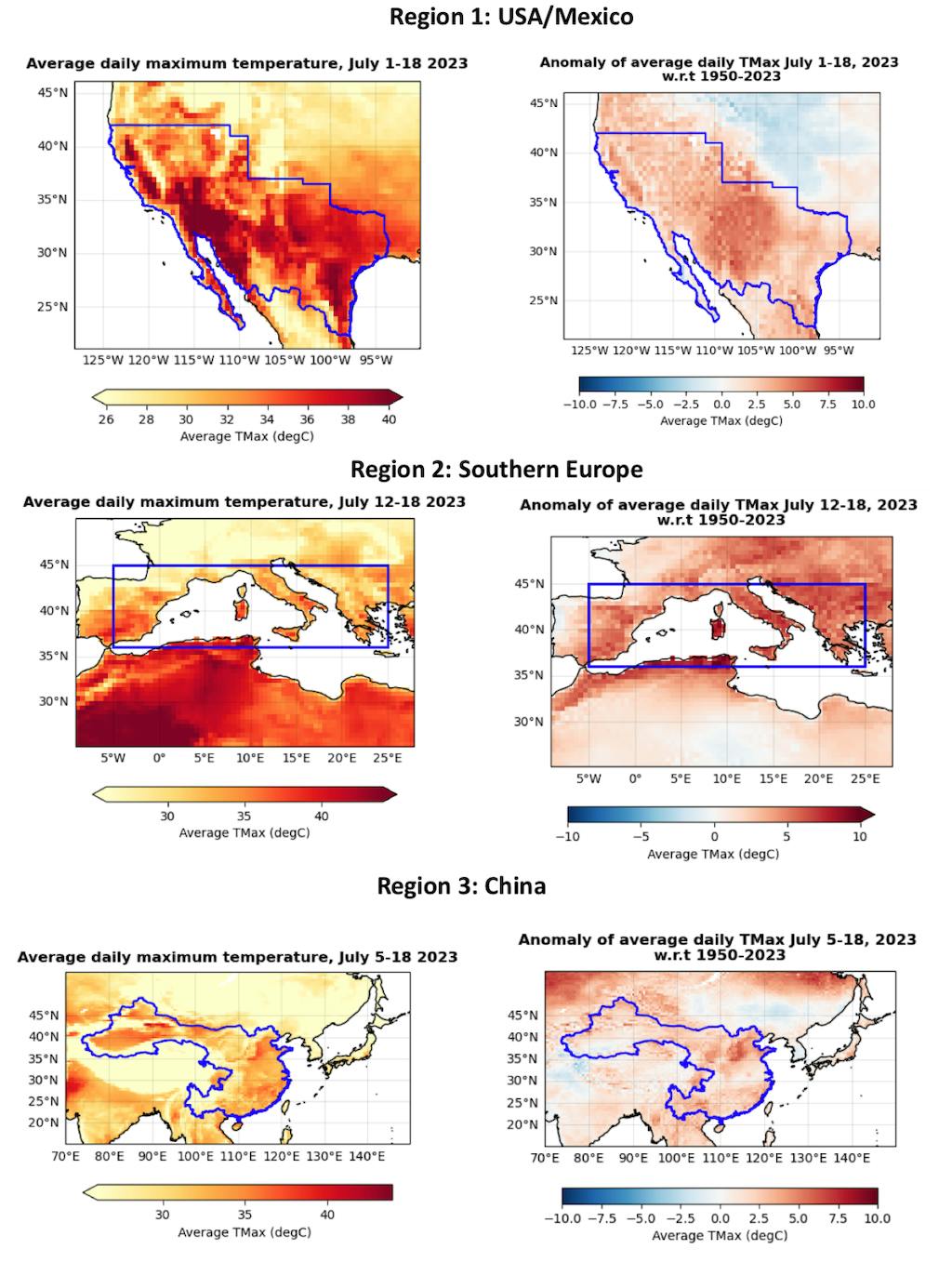Study: Record temperatures for 2023 are no longer rare due to climate change
Weather of Arabia - A new study indicated that the intense heat waves that swept the United States, China and southern Europe in July 2023 "are no longer rare" in our current climate.

Image: Matt Zimmerman, CC BY-SA 3.0, via Flickr.
China records 52.2 degrees Celsius
July 2023 witnessed unprecedented temperatures affecting much of the northern hemisphere, causing temperature records to be broken. The record for the maximum temperature was broken in China on July 16, when the temperature reached 52.2 degrees Celsius.
And at the same time; The United States of America warned nearly a third of the population about the heat earlier in July, as it experienced a historic heat wave that set several records above 100°F (37.8°C).
Infection cases and hospitalizations across Europe rose dramatically as the Cerberus heat wave affected the region.
Scientifically, heat waves in Europe are impossible in a world without climate change
It is worth noting that scientists in climate change and extreme weather conditions had previously indicated that it is scientifically impossible for heat waves to occur in the United States and Europe in a world without climate change.
The report notes that a heat wave in China was "at least 50 times more likely" to be caused by climate change.
The study indicated that the El Niño phenomenon likely contributed some additional heat to heat waves in some areas, but during a press conference, one of the study's authors explained that its effect is "very small compared to the impact of climate change."
The study found that if global average temperatures rise by 2°C above pre-industrial temperatures; That is, an increase of 0.8 ° C from the current situation, the occurrence of such heat waves and extremely high temperatures at this level will be possible to occur every 2-5 years.
The temperatures in July 2023 are breaking records
The first week of July 2023 was the hottest on Earth and across the planet, people are still facing the repercussions of this rise in temperatures so far and records are still being set in many regions.
Carbon Brief analysis showed that extreme weather events around the world this month have appeared on more than 114 front pages in at least 84 newspapers in 32 countries.
What is happening in southern Europe right now is truly terrifying
Highs of 45C are widespread, humans are not able to survive for long such temperatures without artificial cooling
Vulnerable people will die #ClimateCrisis #Cerberus #HeatWaves https://t.co/sy3PI7M1wt pic.twitter.com/TFBB0qt2Vw
— Patrick Galey (@patrickgaley) July 13, 2023
Temperatures in Death Valley in California - which holds the record for the hottest place on Earth - reached 53.3°C on July 16, 2023, approaching the all-time high of 56.7°C set in July 1913.
On July 19, Phoenix recorded a maximum temperature of at least 110 °F (43.3 °C) for the 20th straight day, extending the record broken the previous day.
At 10:56AM MST today, the thermometer at Phoenix Sky Harbor Airport reached 110°F. This now makes today the 20th straight day with a temperature of 110+ °F. #azwx
— NWS Phoenix (@NWSPhoenix) July 19, 2023
Across the Atlantic, southern Europe suffered from the " Cerberus " heatwave, which saw temperatures reach 10 degrees Celsius above average, quickly followed by the " Sharon " heatwave.
Temperatures exceeded 40°C in parts of Spain, France, Italy, Greece and Bosnia, while temperatures in Sicily reached 115°F (46.3°C).
In Rome, a new record high temperature was recorded; It reached ° 41.8 ° C on July 18, and most major cities in Italy were placed on “ high alert and red alert ” due to the intense heat, as meteorological forecasts indicated that parts of the Italian islands of Sardinia and Sicily could reach ° 49 ° C.
China recorded the highest maximum temperature ever on July 16, when the remote town of Sanbao in Turpan region in Xinjiang State witnessed a significant rise in temperatures, reaching a maximum of 52.2 degrees Celsius, breaking the previous record of 50.3 degrees Celsius, which was recorded in 2015. At the same time, Beijing topped the record for the hottest days per year on July 18, with27 days above 35 °C .
Exceptional temperature study
To investigate the exceptionally high temperatures that gripped much of the Northern Hemisphere during July 2023, scientists focused on three separate regions and time periods, where exceptionally high temperatures were reported and affected many people.
The regions were as follows:
- Western United States and Mexico from July 1 to 18
- Southern Europe from 12 to 18 July
- China from July 5 to 18
Dr. Fredika Otto is Professor and Lecturer in Climate Science at the Grantham Institute for Climate Change and the Environment at Imperial College London, co-author of the study and contributing editor to Carbon Brief
She explained in a press conference that different time periods were chosen for different regions to reflect when heat waves most affected people, however she explained that the final results of the study were not very sensitive to accurately define the event.
The maps below show the average maximum temperatures and the difference compared to the average for the period from 1950 to 2023 for the three regions and the selected time periods, with dark red color indicating higher temperatures.

Results
The study found that the warming effect of El Niño - a natural cycle of climate variability - "likely contributed some additional heat to heatwaves in some areas". But Otto stressed at the press conference that its impact is "very small compared to the impact of climate change."
Attribution is a rapidly growing field in climatology that aims to quantify the “fingerprint” of climate change in extreme weather events such as heatwaves and droughts. In this study, the authors investigated the impact of climate change on extreme heat in the three regions chosen for the study.
To conduct attribution studies, scientists use models to compare the world as it is today, where average global temperatures have increased by 1.2°C thanks to human activity, with an “unrealistic” world devoid of human-induced climate change.
This study aimed to distinguish the signal of climate change in heat waves of 18 days in the United States, 7 days in Europe, and 14 days in China, and found that it was virtually impossible for heat waves to occur in the United States and Europe in a world without climate change, while the A heat wave in China is at least 50 times more likely due to climate change.
The authors found that heatwaves in July 2023 in the United States, Europe and China were also 2°C, 2.5°C and 1°C hotter, respectively, than in a world without climate change.
"These events are no longer rare today," the authors warn. In our current climate, the extreme heat we are witnessing in the United States, southern Europe and China can be expected once every 15, 10 and 5 years, respectively.
The authors also warn that if global temperatures reach 2°C above pre-industrial temperatures — 0.8°C more than average global temperatures in today's climate — extremes of heat are on the same scale as those that occurred in July. 2023 could occur every 2-5 years.
The authors began work on this study on July 18, and the results have not yet been published in a peer-reviewed journal. However, the methods used in the analysis have been published in previous attribution studies .

PHOTOGRAPH: LUIS SINCO/GETTY IMAGES
For decades, climate scientists have predicted a rise in the intensity and frequency of extreme heat events. As such, Otto explained at the press conference that the results of this study are "not surprising at all" , noting that we are seeing "exactly what has been predicted in the past".
However, Otto added, our societies and ecosystems are more vulnerable to changes in temperature than previously expected.
Heatwaves are "among the deadliest natural hazards we face every year," Julie Arrigi of the Red Cross and Red Crescent Climate Centre, told the news conference. She stressed the importance of "healthy action plans", pointing to some measures that some countries are currently taking to limit the impact of rising temperatures.
For example, she explained, Italian hospitals reported a sharp rise in admissions during the heat wave and that the government launched a " heat code " to make it easier for patients to get to emergency rooms quickly.
Meanwhile, it reported that electricity consumption has "increased dramatically" in many centers in China. However, power outages remained "very limited" , after measures including backup generators and the hiring of additional staff were implemented.
And she stressed that "it is absolutely necessary to deal with the increase in heat risks." She explained that in the short term, action plans to confront heat and warning systems should be implemented, while in the long term the world must adapt to "critical systems" such as health, electricity and urban planning.
Summary of the study on heat waves and the association of climate change
- Heatwaves are among the deadliest natural hazards with thousands of people dying from heat-related causes each year. However, the full impact of a heatwave is rarely known until weeks or months later, once death certificates have been collected, or when scientists can analyze excess deaths. There are many places that do not have good records of heat-related deaths, and therefore the global death figures currently available are believed to be an underestimate.
-
As indicated by previous climate projections and reports of the Intergovernmental Panel on Climate Change (IPCC), these phenomena are no longer rare. North America, Europe and China have experienced an increase in the frequency of heatwaves over recent years as a result of human-induced warming. Thus, current heat waves are not rare in the current climate, as a similar event is expected approximately once every 15 years in the US/Mexico region, once every 10 years in southern Europe, and once every 5 years in China.
-
Without human-induced climate change, these thermal phenomena would have been very rare. In China, these heatwaves were expected to be a once in 250-year event, while extreme temperatures like July 2023 in the US/Mexico and southern Europe were almost impossible if humans did not warm the planet by burning fuel. fossil.
-
Across all regions, the heatwave we're experiencing today would be significantly cooler in a world without climate change. Similarly to previous studies, we discovered that heatwaves are about 2.5°C warmer in southern Europe, 2°C warmer in North America, and about 1°C warmer in China in the current climate than they would be if there were no human-induced climate change.
-
If the world does not quickly stop burning fossil fuels, these phenomena will become more common, and heat waves will rise and last for longer periods. Heatwaves similar to those we have seen recently will occur every 2-5 years in a world that is 2°C warmer than the climate before the industrial revolution.
-
Heat action plans are increasingly being implemented in the three regions studied and there is evidence that they are reducing heat-related deaths. Furthermore, cities that have planning to deal with extreme heat tend to be cooler and have less impact of heat. There is an urgent need to expedite the implementation of heat action plans in light of the increased vulnerability to heat waves affected by climate change.
Sources:
Arabia Weather App
Download the app to receive weather notifications and more..



